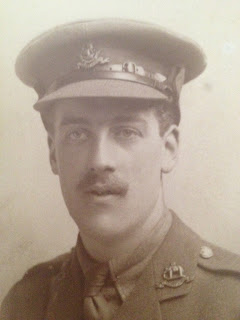The good weather continued and there was continued shelling
by the British, but very little from the Germans. Orders were received that the
Battalion would relieve a Battalion of 70th Brigade, moving forward
to support positions in Peake Wood. Prior to departing, four officers, Lt. Dick Bolton (see 6th September) and 2Lts. David Evans (see 21st
August), Godfrey Isaacs (see 2nd September) and Frederick Millward (see 30th July), were ordered
to return to the transport lines. Advance parties moved off around 3pm and ‘A’
Company took the lead in the main relief, moving off at 6 p.m., and maintaining
a distance of 200 yards between platoons, followed, at ten minute intervals by
‘B’, ‘C’ and ‘D’ Companies. Behind them followed the Battalion’s cookers and
water carts which would be established in Peake Wood. The men marched off
carrying full packs and wearing their steel helmets.
 |
Lt. Dick Bolton
Image by kind permission of Henry Bolton
|
2Lt. and acting adjutant, Hugh William Lester (see 11th
July), was formally confirmed in his role on a temporary basis and promoted
Temporary Lieutenant whilst so employed, with seniority and pay from 14th
July.
In a letter home to his wife, Brig. Genl. T.S. Lambert (see passim) commented on the improved
weather and also shared his observations on the current state of affairs:
“We are moving again but only in a small way. Of course we
have been there before several times. It has changed a bit but is now not quite
so near the front line as it once was though Boche daily puts some heavy stuff
into it still. Col. Walker that I wrote about (see 24th September) was killed there only the other day.
It has changed a bit since we last occupied it but is not an uncomfortable
spot. Now it is fine again I am hoping the good weather will continue. The push
still continues as you will have seen in the papers and we have done well
yesterday and today further South, as have the French. I do not think we have
much love left for our enemies in this part of the world and the longer we go
on the more I hope we shall manage to rid ourselves of.”
(I am greatly indebted
to Juliet Lambert for her generosity in allowing me to reproduce the letters
here). |
Brig. Genl. T.S. Lambert
Image by kind permission of Juliet Lambert
|
Pte. Thomas Angus
McAndrew (see 2nd May)
was posted back to England. At some point in the previous few weeks (the
precise date is unknown), he had been wounded in a shell explosion, suffering a
fractured ankle and some symptoms of neurasthenia (shellshock). He had been
treated at 23rd General Hospital at Etaples and on returning to
England would receive further treatment at both St. George’s Hospital,
Stockport and Harewood House, Disley.
Pte. William Walton (see 11th August),
who had been in England since June after suffering from influenza, was posted
back to France. He would spend two weeks at 34th Infantry Base Depot
at Etaples and then, rather than re-joining 10DWR, would be posted to 8DWR.
Official notice of the award of the DSO to 2Lt. Bob Perks (see 24th September) was published in the London Gazette:
“His Majesty the King has been graciously pleased to approve
of the appointments of the undermentioned Officers to be Companions of the
Distinguished Service Order, in recognition of their gallantry and devotion to
duty in the field:
Temp. 2nd Lt. Robert Clement Perks, W. Rid. R.
For conspicuous gallantry during operations. When leading a bombing party, he was wounded in the face and rendered insensible. On recovering, he again took part in the attack. While throwing bombs he was again twice wounded, in the hand and foot, but continued to lead his men till rendered unconscious by a fourth wound in the face.”
(I am greatly indebted to Janet Hudosn for her generosity in allowing me to reproduce the letters here).Temp. 2nd Lt. Robert Clement Perks, W. Rid. R.
For conspicuous gallantry during operations. When leading a bombing party, he was wounded in the face and rendered insensible. On recovering, he again took part in the attack. While throwing bombs he was again twice wounded, in the hand and foot, but continued to lead his men till rendered unconscious by a fourth wound in the face.”
 |
2Lt. Bob Perks, DSO
Image by kind permission of Janet Hudson
|
Enquiries continued regarding 2Lt Roland Herbert Wyndham Brinsley-Richards (see 22nd September) who was officially reported ‘missing in action’ following the attack on Munster Alley. A statement was taken, at no.10 General Hospital, Rouen, from Pte. A. Dean. He reported, “I was with the machine gun at Horseshoe Trench near Contalmaison (sic. this was actually 5th July). Mr. Richards led the Company over the parapet and on the tiop of the German parapet he was shot by machine gun fire. I saw him shot. We were about 200 yards behind, and when I got in the trench I saw his body”.
Pte. Angus Dean had been commended for his work in
maintaining communications during the actions around Munster Alley (see 30th
July); he later served with both 8DWR and 2/5DWR.
 |
| 2Lt. R.H.W. Brinsley-Richards |
Having completed his cadet training at the Royal Military
College, Sandhurst, Herbert Middleton
Hands (known as ‘Bob’) completed a form stating his preference as to
Regiment he would prefer to be gazetted; he gave the Worcesters as his first
preference, with the West Ridings as second choice. He would, in fact, be
posted firstly to 2DWR and latterly to 10DWR. Bob Hands was 18 years old and
the eldest child of Herbert and Helen Hands; his father was the managing
director of a South American trading company and the family lived in
Kenilworth.
No comments:
Post a Comment